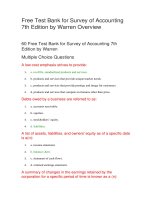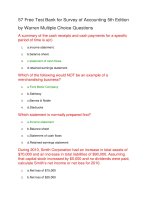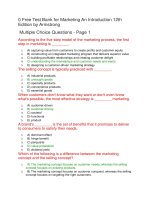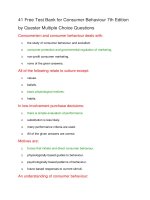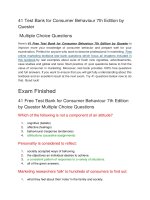41 free test bank with answersfor consumer behaviour 7th edition
Bạn đang xem bản rút gọn của tài liệu. Xem và tải ngay bản đầy đủ của tài liệu tại đây (57.91 KB, 14 trang )
41 Free Test Bank for Consumer Behaviour 7th Edition
by Quester Multiple Choice Questions
Consumerism and consumer behaviour deals with:
1.
the study of consumer behaviour and socialism.
2.
consumer protection and governmental regulation of marketing.
3.
non-profit consumer marketing.
4.
none of the given answers.
All of the following relate to culture except:
1.
values.
2.
beliefs.
3.
basic physiological motives.
4.
habits.
In low-involvement purchase decisions:
1.
there is simple evaluation of performance.
2.
substitution is less likely.
3.
many performance criteria are used.
4.
All of the given answers are correct.
Motives are:
1.
forces that initiate and direct consumer behaviour.
2.
physiologically based guides to behaviour.
3.
psychologically based patterns of behaviour.
4.
future based responses to current stimuli.
An understanding of consumer behaviour:
1.
is based on the corporate strategy.
2.
Page 2 of 8is not considered by top executives in large multinational
companies.
3.
is only useful for planning purposes but not for managing purposes.
4.
contributes to the long-term success of a company's products.
Benefit segmentation:
1.
2.
is useful only for business-to-business products.
involves a focus on the particular outcome consumers seek from using a
product.
3.
involves a focus on emotional appeals.
4.
is useful only for consumer products.
The household:
1.
has a regular life cycle.
2.
has a predictable life cycle.
3.
4.
can be used to develop aggregate pictures of the purchase needs of
individuals at each stage.
All of the given answers are correct.
Which of the following is not a component of an attitude?
1.
cognitive (beliefs)
2.
affective (feelings)
3.
behavioural (response tendencies)
4.
attributions (causative assignments)
Attitudes represent:
1.
a basic orientation for or against some object.
2.
non-factual as opposed to factual information.
3.
emotional as opposed to rational evaluations.
4.
Page 6 of 8subjective as opposed to objective feelings.
Postmodernists believe all of the following except:
1.
that all reality is constructed by the individual or group.
2.
that knowledge is independent of time.
3.
4.
that all reality is determined by an individual or group even more than by
objective reality.
that there are multiple realities.
Which is not an element of the marketing mix?
1.
product
2.
people
3.
place
4.
price
Marketing researchers 'talk' to hundreds of consumers to find out:
1.
what they feel about their 'roles' in the family and society.
2.
how they use various products.
3.
their hopes and dreams for themselves and their families.
4.
all of the given answers.
In high-involvement purchase decisions:
1.
there is limited external information search.
2.
problem recognition is trivial to minor.
3.
many alternatives are considered.
4.
substitution is highly possible.
Personality is considered to reflect:
1.
socially accepted ways of behaving.
2.
the objectives an individual desires to achieve.
3.
a consistent pattern of responses to a variety of situations.
4.
all of the given answers.
A group is made up of:
1.
2.
people who tend to know each other.
two or more people who have a purpose for interacting over some extended
period of time.
3.
two or more people who occupy the same space in any one moment.
4.
all of the given answers.
To be successful, a new product:
1.
must be a true innovation.
2.
must be priced higher than competing products when first introduced.
3.
must be priced lower than competing products when first introduced.
4.
must solve a consumer problem.
Positioning:
1.
can be based only on real product advantages.
2.
is the same as repositioning.
3.
is the way a product compares to its competitors, as perceived by consumers.
4.
is generally limited to observable behaviour.
Non-verbal communication:
1.
is irrelevant for marketing strategy.
2.
is important in dealing with other cultures.
3.
is the same across all cultures.
4.
None of the given answers are correct.
We learn our culture and social class through:
1.
reference groups.
2.
the mass media.
3.
religious institutions.
4.
all of the given answers.
Postmodernists use:
1.
ethnography.
2.
content analysis of popular media.
3.
Page 7 of 8introspection.
4.
all of the given answers.
Modernism is based on:
1.
reason and a rational order.
2.
autonomous investigators and subjects.
3.
the existence of a single objective reality.
4.
all of the given answers.
Social class:
1.
is unrelated to consumer lifestyle.
2.
relates only to purchase of durable goods.
3.
does not relate to values and attitudes.
4.
relates to ranking of individuals.
Which is the following is not one of the major questions related to
social class?
1.
On what characteristics is the social structure is built?
2.
What degree of consumerism is there in a given society?
3.
To what extent do various societies structure and rank individuals?
4.
In what ways does the social structure influence consumer lifestyle?
The post-purchase process involves:
1.
consumer redress.
2.
consumer satisfaction.
3.
product safety.
4.
all of the given answers.
The product section of the consumer behaviour audit covers which
of the following influences?
1.
external
2.
internal
3.
decision-process
4.
all of the given answers.
Injurious consumption is:
1.
the way an individual behaves in a group.
2.
consumer behaviour that may be harmful to oneself.
3.
consumer behaviour that may be harmful to others.
4.
all of the given answers.
The consumer behaviour audit is a:
1.
review of marketing recommendations.
2.
checklist to evaluate marketing strategies.
3.
systematic review of all important aspects of consumer behaviour.
4.
5.
checklist to evaluate marketing strategies and systematic review of all
important aspects of consumer
behaviour.
Consumer behaviour is:
1.
a complex, multidimensional process.
2.
easily understood by marketing managers.
3.
a complex, unidimensional process.
4.
none of the given answers.
Post-purchase process includes:
1.
use.
2.
disposal.
3.
repurchase behaviour.
4.
all of the given answers.
Which of the following often leads to lifestyle changes?
1.
the results of past consumption decisions
2.
time-related events such as ageing
3.
external events such as a job change
4.
Page 4 of 8 all of the given answers
Customer value is:
1.
2.
derived from the price of the product.
the difference between all of the benefits derived from the total product and all
of the costs of acquiring those
3.
products.
4.
the cost to the consumer of altering their behaviour to buy a product.
5.
6.
the difference between the perceived financial and social costs in obtaining
the product and the financial and
social gain in owning the product.
Postmodernists tend to view knowledge as being dependent on all
of the following except:
1.
time.
2.
culture.
3.
geography.
4.
context.
Examples of injurious consumption include:
1.
abusing a loved one.
2.
gambling as an addiction that leads to bankruptcies.
3.
over-consumption of alcohol that leads to road accidents.
4.
5.
gambling as an addiction that leads to bankruptcies and over-consumption of
alcohol that leads to road
accidents.
Which of the following is not an example of internal influences in the
consumer behaviour audit?
1.
Is the product suited for particular personality types?
2.
Who in the household evaluates the price of the product?
3.
What is the ideal version of this product in each market segment?
4.
Will price be perceived as an indicator of status?
Groups serve as a ____________ and as a ___________ for the
individual.
1.
social stimulant; social determinant
2.
segmentation point; target market
3.
reference point; source of information
4.
None of the given answers are correct.
Global marketing is:
1.
rapidly sweeping the world and leading to the largest period of sustained
global economic growth ever
2.
experienced.
3.
the cause of consumerism.
4.
a form of international marketing that aims to target particular consumer
segments using a standardised
5.
marketing mix.
6.
necessary for any company to understand consumer behaviour.
The consumer decision-making process begins with:
1.
marketing efforts.
2.
the recognition of a difference between an existing and a desired state.
3.
the alternatives available.
4.
none of the given answers.
Consumer lifestyle includes:
1.
a focus on luxury goods.
2.
good and services we buy.
3.
rejection of materialism.
4.
none of the given answers.
Consumer behaviour draws on many disciplines, such as:
1.
clinical psychology.
2.
experimental psychology.
3.
sociology.
4.
all of the given answers.
Consumer behaviour theory provides the manager with:
1.
more problems than it solves.
2.
concrete solutions to most marketing problems.
3.
the proper questions to ask in specific market decision situations.
4.
none of the given answers.
The marketing manager should view the consumer as:
1.
a decision-making unit.
2.
a problem solver.
3.
being primarily concerned with economic factors.
4.
automatically responding in set ways to marketing stimuli.
20 Free Test Bank for Internet Marketing 3rd Edition by
Roberts Multiple Choice Questions
Technology that can integrate location into marketing applications is
called:
1.
a. apps.
2.
b. Web 3.0.
3.
c. GPS.
The most common way consumers discover new online products is
through:
1.
a. search.
2.
b. merchant emails.
3.
c. social networking sites.
Sales force.com exemplifies:
1.
a. a “cloud computing” product that shows the power of connectivity in a
network.
2.
b. a proprietary product used by a single user.
3.
c. technology that is used primarily to develop proprietary software.
The basic business models used on the Internet include:
1.
a. multi-channel marketing.
2.
b. target return on investment.
3.
c. disintermediation.
A website must be hosted on a ________.
1.
a. browser
2.
b. interactive device
3.
c. server
Objectives that can be appropriate for Internet marketing include:
1.
a. building loyal customer relationships.
2.
b. doubling the customer base.
3.
c. decreasing the need for customer service.
The phenomenon we call "the Internet bubble" was characterized
by:
1.
a. many Internet businesses that had not attained profitability.
2.
b. venture capital available to even questionable business models.
3.
c. both of the above.
Businesses have enthusiastically adopted the internet for marketing
for the following:
1.
a. attract new customers.
2.
b. customer retention.
3.
c. both of the above.
________ is the feature of the Internet that allows users to move
easily from one document to another.
1.
a. Telecommunications
2.
b. Common platform
3.
c. Hypertext
Which is not among the four distinct generic goals of Internet
marketing?
1.
a. Acquisition
2.
b. Conversion
3.
c. Mobile access
The Sabre System is an example of:
1.
a. an information product that existed prior to the Internet.
2.
b. the evolution of an internal system into a commercial product.
3.
c. both of the above.
Which of the following is a true statement about the Internet
infrastructure stack?
1.
a. It describes activities that can be performed inside the business or
outsourced to independent suppliers.
2.
b. It describes the manner in which different elements come together to create
the Internet environment.
3.
c. Both of the above.
Web 2.0 is characterized by:
1.
a. services and co-creation.
2.
b. economic and technical evolution.
3.
c. a "dot com" business enterprise.
The Internet experienced slow but steady growth until ________
allowed users to move around in easy graphical fashion.
1.
a. Yahoo!
2.
b. Mosaic
3.
c. Netscape
Which of the following is a true statement about the origins of the
Internet?
1.
a. The Internet was initially conceptualized in a term paper by a computer
science student at Stanford.
2.
b. The Internet was initially developed by a number of technology companies
that wanted to expand the market for their products.
3.
c. The Internet was initially developed by DARPA to fund research in
communications technology for defense purposes.
________ is the communications protocol that provides the
common “language” of Internet computing.
1.
a. TCP/IP
2.
b. HTML
3.
c. The graphic browser
Which of the following is not an element of the Internet
infrastructure stack?
1.
a. Website content
2.
b. Operations like load balancing and security
3.
c. Connections to the telecommunications backbone of the Internet
The Sabre System is an example of:
1.
a. a new service made possible by the Internet.
2.
b. an information product.
3.
c. a product targeted solely at the consumer market.
Term often used when software is made available on a fee for
usage basis:
1.
a. Applications Software Providers.
2.
b. Proprietary Software.
3.
c. Software as a Service.
Which of the following is not a strategic driver of the Internet
economy?
1.
a. Speed is essential to successful Internet operations.
2.
b. Employees can easily be substituted for one another.
3.
c. Making it possible to deal with customers on a 1-to-1 basis.

